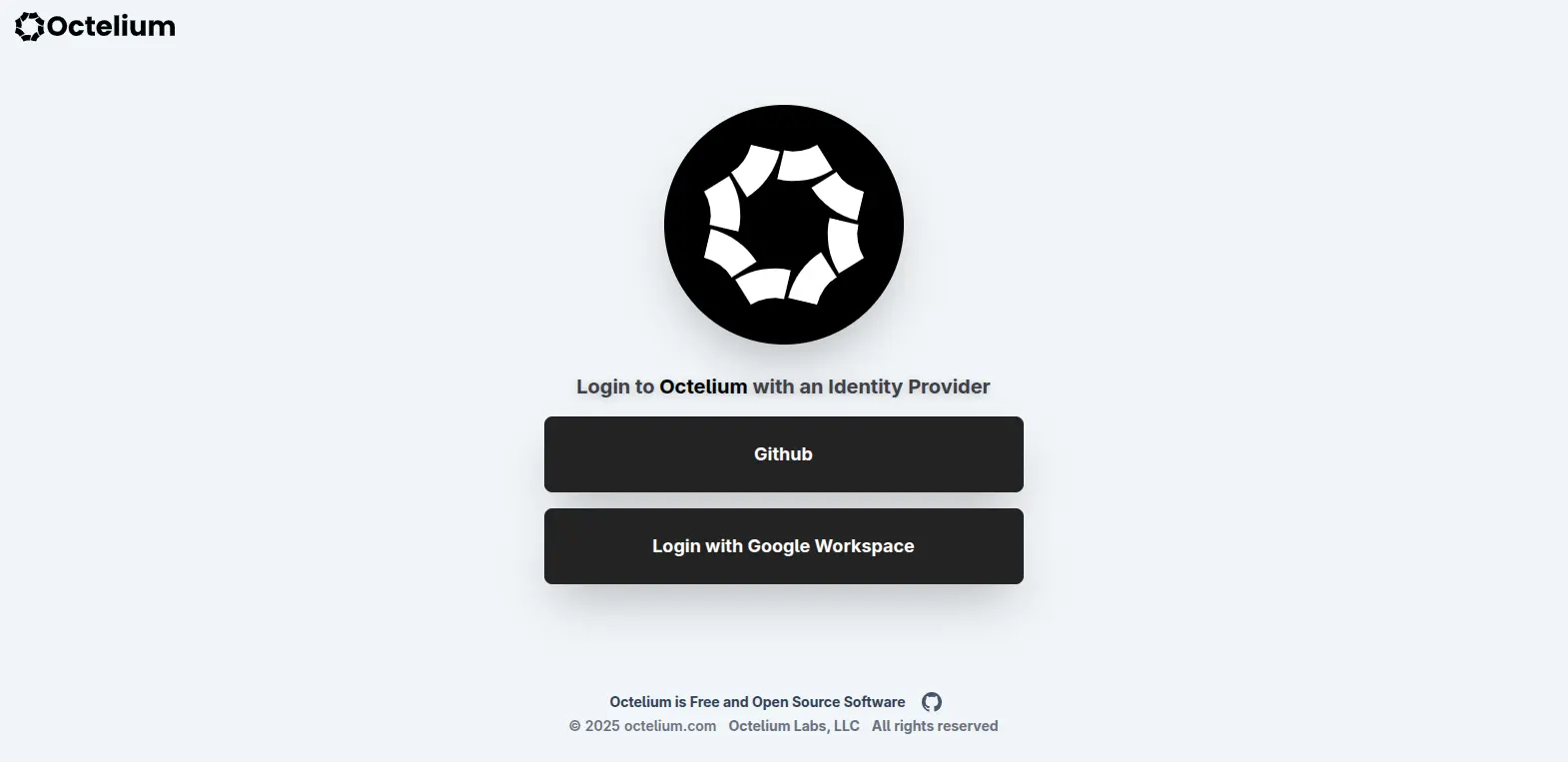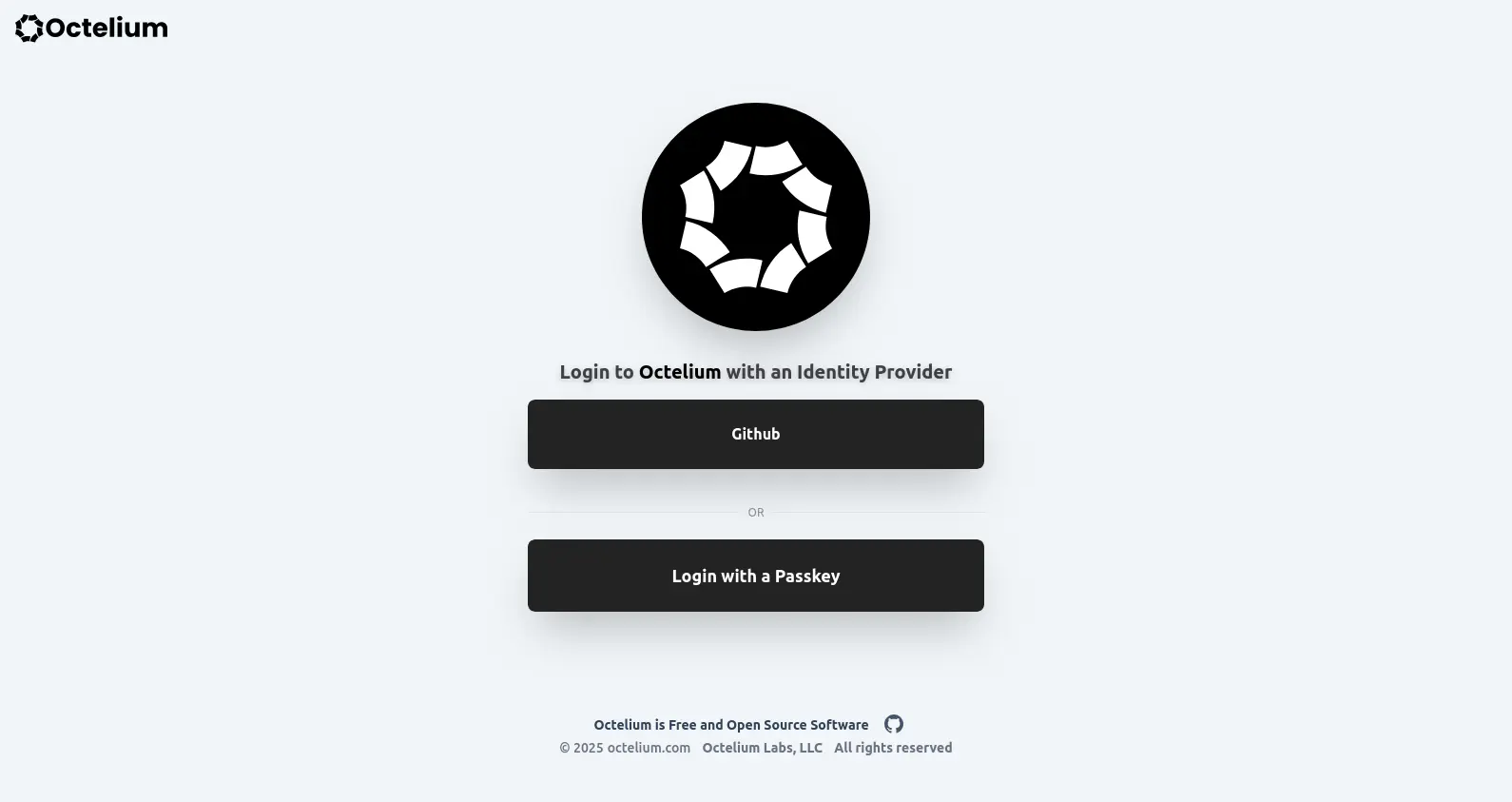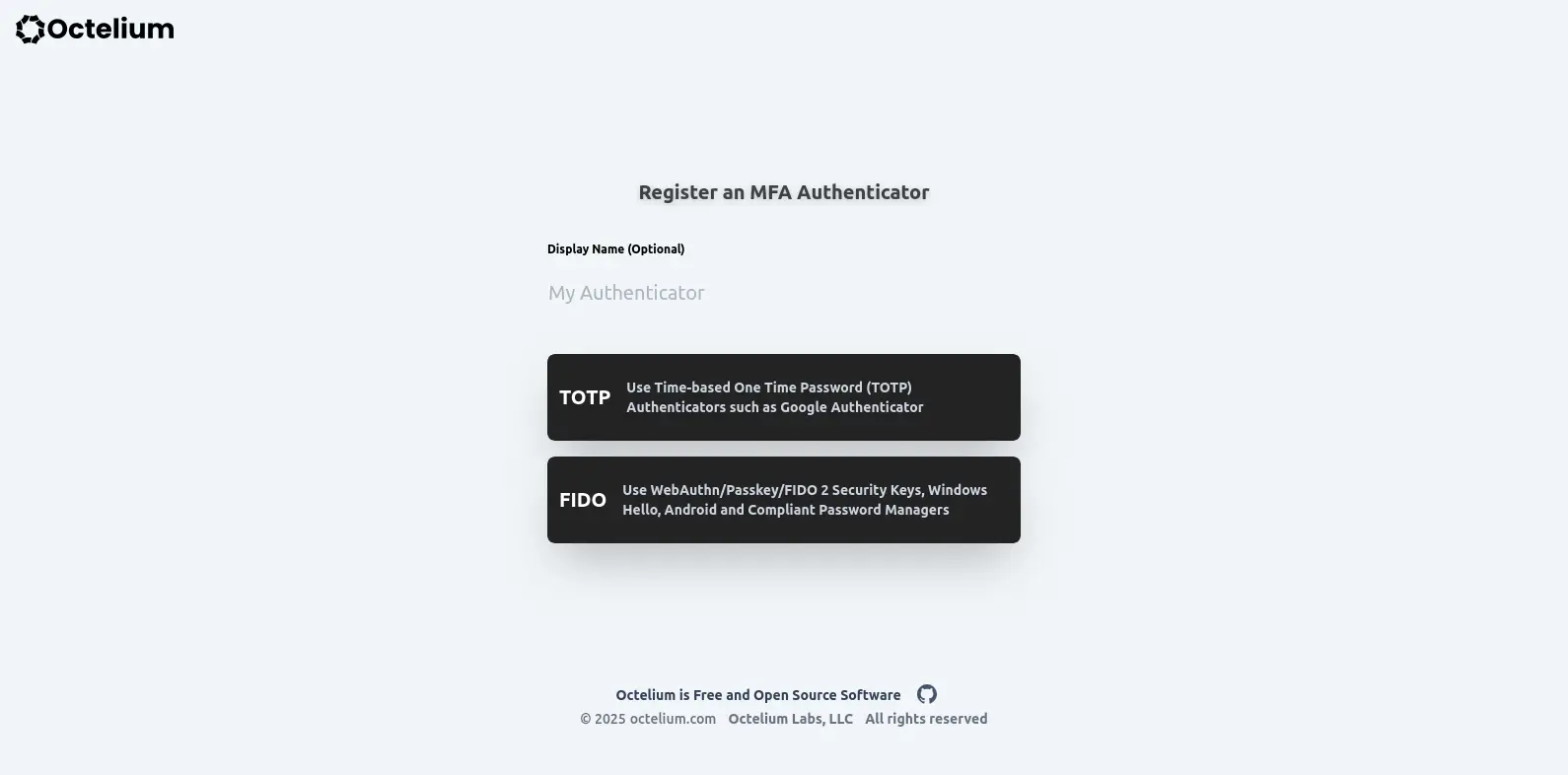The octelium and octeliumctl CLIs currently provide multiple ways for Users to authenticate themselves in order to create a new valid Session in order to able to interact with the Cluster and access its Services.
Initial authentication can be achieved through one of the following methods:
- Web identity providers (IdPs) such as any OpenID Connect or SAML 2.0 providers (e.g. Okta, Azure AD, etc...). This is available for
HUMANUsers as shown below. - Authentication tokens which can be used mainly by
WORKLOADUsers but can also be used byHUMANUsers. - Assertion tokens (e.g. OIDC-based assertions) which are used by
WORKLOADUsers.
Users can also re-authenticate their already existent Session via Authenticators and Device authentication to extend the validity of their Sessions.
Web Identity Providers
HUMAN Users can easily login to a Cluster via the command:
octelium login --domain <DOMAIN># ORexport OCTELIUM_DOMAIN=example.com# using octeliumoctelium login# OR using octeliumctlocteliumctl login# OR more specifically via the --web flagoctelium login --web
Read more about the OCTELIUM_DOMAIN environment variable and the --domain
flag here

This will open a browser window for the User to authenticate themselves via the available identity providers defined by the Cluster. Once authenticated, the User can then interact with the Cluster via octelium or octeliumctl, connect to the Cluster and access its Services.
Passkey Login
Once you're logged in, you can register an Authenticator, including a WebAuthn FIDO2 Passkey Authenticators such as Yubikeys and Google Password Manager. Once registered, you can use the Authenticator to login directly as shown below, if allowed by the Cluster (read more here).

To register a TOTP or FIDO2 WebAuthn/Passkey Authenticator that can be used later for authentication, press on the "Authenticators" button in the left sidebar of the Portal, which is the Service you're redirected to by default once you're logged in.

Authentication Token
The second way for authenticating Users in order to obtain Sessions is via authentication tokens. You can use the Credential either using octelium login or octeliumctl login. You can also use the authentication token Credential to directly connect to the Cluster in a single step using the octelium connect command without having to use octelium login. This can be useful for running octelium inside containers or other programmable environments. Here are some examples:
export OCTELIUM_DOMAIN=example.com# using octeliumoctelium login --auth-token <TOKEN># OR using octeliumctlocteliumctl login --auth-token <TOKEN># Authenticate and connect directly. Useful when used by automated environments (e.g. containers)octelium connect --auth-token <TOKEN>
You can also use the OCTELIUM_AUTH_TOKEN environment variable instead of having to use the --auth-token flag. This can be especially useful for containerized and cloud-based environments where you can store the authentication token as a secret that's exposed in runtime as an environment variable. It works simply as follows:
export OCTELIUM_AUTH_TOKEN=<TOKEN>export OCTELIUM_DOMAIN=example.comoctelium login# Or login and connect directlyoctelium connect
Access Token
You can also use an access token (read more here) directly in your octelium and octeliumctl commands without having to login/authenticate via the OCTELIUM_ACCESS_TOKEN environment variable as follows:
export OCTELIUM_ACCESS_TOKEN=<ACCESS_TOKEN>export OCTELIUM_DOMAIN=example.comocteliumctl get svcoctelium statusoctelium connect
OIDC-based Assertion Authentication for Workloads
WORKLOAD Users can use OpenID Connect based assertion to authenticate to the Cluster in a "secretless" way without having to use an authentication token Credential.
octelium login --assertion <AUTHENTICATION_METHOD_NAME>:<ASSERTION_TYPE>[:<OPTIONS>]
You can also use the OCTELIUM_AUTH_ASSERTION environment variable as a replacement for the --assertion flag as follows:
export OCTELIUM_AUTH_ASSERTION=<AUTHENTICATION_METHOD_NAME>:<ASSERTION_TYPE>[:<OPTIONS>]export OCTELIUM_DOMAIN=example.comoctelium login# Or login and connect directlyoctelium connect
Kubernetes
The Kubernetes mode is designed for WORKLOAD Users running from within Kubernetes pods. It simply looks for the service account ID token stored in the /var/run/secrets/kubernetes.io/serviceaccount/token path and uses it as the assertion.
octelium login --assertion k8s-idp-01:k8s
Azure
This mode works for WORKLOAD Users running on Azure services that support managed identity and can obtain an access token that is used as an assertion (read more here).
octelium login --assertion azure-01:azure
By default, the Cluster domain (e.g. example.com) is used as the audience. You can override the audience as follows:
octelium login --assertion azure-01:azure:audience=custom-aud
GitHub Actions
This mode works for WORKLOAD Users running from within GitHub actions workflows (read more here).
octelium login --assertion gh-01:github-actions
By default, the Cluster domain (e.g. example.com) is used as the audience. You can override the audience as follows:
octelium login --assertion gh-01:github-actions:audience=custom-aud
JWT
For other environments, you can directly use the issued JWT assertion that can be found in either a file path or an environment variable.
Here is an example for a JWT assertion that is stored in a file:
octelium login --assertion jwt-01:jwt:file=/path/to/jwt-file
You can also use a JWT that is stored in an environment variable as follows:
octelium login --assertion jwt-02:jwt:env=JWT_KEY
Registering Device
You can register/enroll or re-register your Device via the octelium auth device register or simply octelium auth dev as follows:
octelium auth dev# OR using octeliumctlocteliumctl auth dev
Logout from a Cluster
Logging out simply removes your Session both locally and at the Cluster side. Once you log out from a Cluster, you have to login again through one of the above methods in order to be able to interact with the Cluster again.
# using octeliumoctelium logout# OR using octeliumctlocteliumctl logout